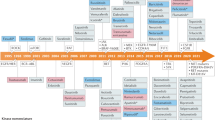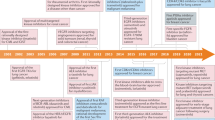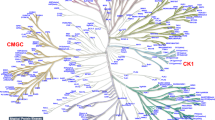Abstract
The majority of kinase inhibitors that have been developed so far—known as type I inhibitors—target the ATP binding site of the kinase in its active conformation, in which the activation loop is phosphorylated. Recently, crystal structures of inhibitors such as imatinib (STI571), BIRB796 and sorafenib (BAY43-9006)—known as type II inhibitors—have revealed a new binding mode that exploits an additional binding site immediately adjacent to the region occupied by ATP. This pocket is made accessible by an activation-loop rearrangement that is characteristic of kinases in an inactive conformation. Here, we present a structural analysis of binding modes of known human type II inhibitors and demonstrate that they conform to a pharmacophore model that is currently being used to design a new generation of kinase inhibitors.
This is a preview of subscription content, access via your institution
Access options
Subscribe to this journal
Receive 12 print issues and online access
$259.00 per year
only $21.58 per issue
Buy this article
- Purchase on Springer Link
- Instant access to full article PDF
Prices may be subject to local taxes which are calculated during checkout






Similar content being viewed by others
References
Manning, G., Whyte, D.B., Martinez, R., Hunter, T. & Sudarsanam, S. The protein kinase complement of the human genome. Science 298, 1912–1934 (2002).
Hunter, T. The role of tyrosine phosphorylation in cell growth and disease. Harvey Lect. 94, 81–119 (1998).
Cohen, P. Protein kinases—the major drug targets of the twenty-first century? Nat. Rev. Drug Discov. 1, 309–315 (2002).
Mol, C.D., Fabbro, D. & Hosfield, D.J. Structural insights into the conformational selectivity of STI-571 and related kinase inhibitors. Curr. Opin. Drug Discov. Devel. 7, 639–648 (2004).
Schindler, T. et al. Structural mechanism for STI-571 inhibition of abelson tyrosine kinase. Science 289, 1938–1942 (2000).
Pargellis, C. et al. Inhibition of p38 MAP kinase by utilizing a novel allosteric binding site. Nat. Struct. Biol. 9, 268–272 (2002).
Wan, P.T. et al. Mechanism of activation of the RAF-ERK signaling pathway by oncogenic mutations of B-RAF. Cell 116, 855–867 (2004).
Manley, P.W. et al. Advances in the structural biology, design and clinical development of VEGF-R kinase inhibitors for the treatment of angiogenesis. Biochim. Biophys. Acta 1697, 17–27 (2004).
Gill, A.L. et al. Identification of novel p38α MAP kinase inhibitors using fragment-based lead generation. J. Med. Chem. 48, 414–426 (2005).
Cumming, J.G. et al. Novel, potent and selective anilinoquinazoline and anilinopyrimidine inhibitors of p38 MAP kinase. Bioorg. Med. Chem. Lett. 14, 5389–5394 (2004).
Heron, N.M. et al. SAR and inhibitor complex structure determination of a novel class of potent and specific Aurora kinase inhibitors. Bioorg. Med. Chem. Lett. 16, 1320–1323 (2006).
Traxler, P. & Furet, P. Strategies toward the design of novel and selective protein tyrosine kinase inhibitors. Pharmacol. Ther. 82, 195–206 (1999).
Jung, F.H. et al. Discovery of novel and potent thiazoloquinazolines as selective Aurora A and B kinase inhibitors. J. Med. Chem. 49, 955–970 (2006).
Dai, Y. et al. Thienopyrimidine ureas as novel and potent multitargeted receptor tyrosine kinase inhibitors. J. Med. Chem. 48, 6066–6083 (2005).
Gray, N.S. et al. Exploiting chemical libraries, structure, and genomics in the search for kinase inhibitors. Science 281, 533–538 (1998).
Liu, Y. et al. Structural basis for selective inhibition of Src family kinases by PP1. Chem. Biol. 6, 671–678 (1999).
Wang, Z. et al. Structural basis of inhibitor selectivity in MAP kinases. Structure 6, 1117–1128 (1998).
Wilson, K.P. et al. The structural basis for the specificity of pyridinylimidazole inhibitors of p38 MAP kinase. Chem. Biol. 4, 423–431 (1997).
Hubbard, S.R., Wei, L., Ellis, L. & Hendrickson, W.A. Crystal structure of the tyrosine kinase domain of the human insulin receptor. Nature 372, 746–754 (1994).
Nagar, B. et al. Crystal structures of the kinase domain of c-Abl in complex with the small molecule inhibitors PD173955 and imatinib (STI-571). Cancer Res. 62, 4236–4243 (2002).
Manley, P.W. et al. Imatinib: a selective tyrosine kinase inhibitor. Eur. J. Cancer 38 (suppl. 5), S19–S27 (2002).
Regan, J. et al. Pyrazole urea-based inhibitors of p38 MAP kinase: from lead compound to clinical candidate. J. Med. Chem. 45, 2994–3008 (2002).
Lowinger, T.B., Riedl, B., Dumas, J. & Smith, R.A. Design and discovery of small molecules targeting raf-1 kinase. Curr. Pharm. Des. 8, 2269–2278 (2002).
Atwell, S. et al. A novel mode of Gleevec binding is revealed by the structure of spleen tyrosine kinase. J. Biol. Chem. 279, 55827–55832 (2004).
Wood, E.R. et al. A unique structure for epidermal growth factor receptor bound to GW572016 (Lapatinib): relationships among protein conformation, inhibitor off-rate, and receptor activity in tumor cells. Cancer Res. 64, 6652–6659 (2004).
Shewchuk, L. et al. Binding mode of the 4-anilinoquinazoline class of protein kinase inhibitor: X-ray crystallographic studies of 4-anilinoquinazolines bound to cyclin-dependent kinase 2 and p38 kinase. J. Med. Chem. 43, 133–138 (2000).
Adams, J.L., Kasparec, J., Silva, D. & Yuan, C.C.K. Preparation of pyrazolo[3,4-d]pyrimidine derivatives for treating diseases associated with inappropriate angiogenesis. World patent application WO2003029209 (2003).
Kubo, K. et al. Novel potent orally active selective VEGFR-2 tyrosine kinase inhibitors: synthesis, structure-activity relationships, and antitumor activities of N-phenyl-N'-{4-(4-quinolyloxy)phenyl}ureas. J. Med. Chem. 48, 1359–1366 (2005).
Hoelzemann, G. et al. Preparation of heteroaryl-substituted diarylureas as tyrosine kinase inhibitors. World patent application WO2005019192 (2005).
Sim, T. et al. Preparation of pyrimidopyrimidines as protein kinase inhibitors. World patent application WO2005011597 (2005).
Ding, Q. et al. Preparation of [1,6]naphthyridin-3-ones as protein kinase inhibitors. ç patent application WO2005034869 (2005).
Ren, P., Wang, X., Gray, N.S., Liu, Y. & Sim, T. Preparation of N-[3-(2-amino-7-oxo-7,8-dihydropteridin-6-yl)phenyl] benzamides as protein kinase inhibitors. World patent application WO2006002367 (2006).
Fabian, M.A. et al. A small molecule–kinase interaction map for clinical kinase inhibitors. Nat. Biotechnol. 23, 329–336 (2005).
Klebl, B.M. & Muller, G. Second-generation kinase inhibitors. Expert Opin. Ther. Targets 9, 975–993 (2005).
Noble, M. et al. Exploiting structural principles to design cyclin-dependent kinase inhibitors. Biochim. Biophys. Acta 1754, 58–64 (2005).
Pratt, D.J., Endicott, J.A. & Noble, M.E. The role of structure in kinase-targeted inhibitor design. Curr. Opin. Drug Discov. Devel. 7, 428–436 (2004).
Acknowledgements
We wish to acknowledge the Novartis Research Foundation for funding and C. Liang, Y.-T. Chang, A. Wojciechowski and the GNF kinase platform for helpful comments and discussions.
Author information
Authors and Affiliations
Ethics declarations
Competing interests
The authors declare no competing financial interests.
Rights and permissions
About this article
Cite this article
Liu, Y., Gray, N. Rational design of inhibitors that bind to inactive kinase conformations. Nat Chem Biol 2, 358–364 (2006). https://doi.org/10.1038/nchembio799
Published:
Issue Date:
DOI: https://doi.org/10.1038/nchembio799
This article is cited by
-
Deciphering the molecular choreography of Janus kinase 2 inhibition via Gaussian accelerated molecular dynamics simulations: a dynamic odyssey
Journal of Computer-Aided Molecular Design (2024)
-
Indole-based FLT3 inhibitors and related scaffolds as potential therapeutic agents for acute myeloid leukemia
BMC Chemistry (2023)
-
LRRK2 phosphorylation status and kinase activity regulate (macro)autophagy in a Rab8a/Rab10-dependent manner
Cell Death & Disease (2023)
-
Novel potent and highly selective DDR1 inhibitors from integrated lead finding
Medicinal Chemistry Research (2023)
-
New apoptotic anti-triple-negative breast cancer theobromine derivative inhibiting EGFRWT and EGFRT790M: in silico and in vitro evaluation
Molecular Diversity (2023)



